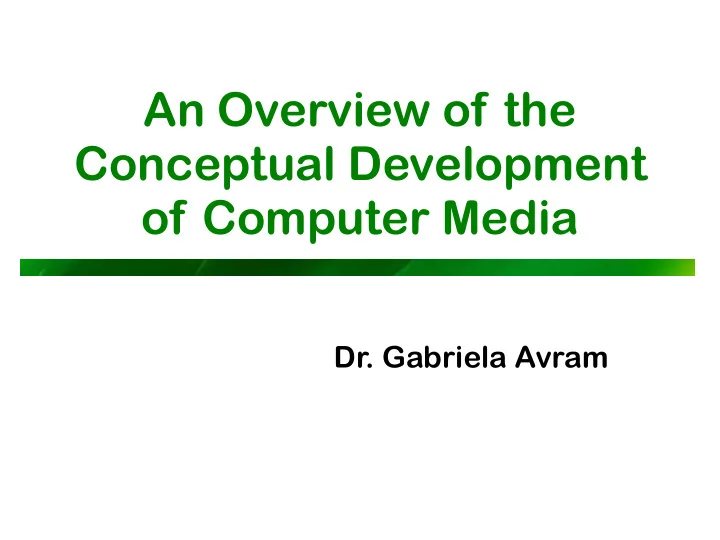

An Overview of the Conceptual Development of Computer Media Dr. Gabriela Avram
Readings: p Introduction. From Logic Machines to the Dynabook: An Overview of the Conceptual Development of Computer Media – Paul A.Mayer (excerpt under Readings in Sulis)
Timeline p Gottfried Wilhelm p Vannevar Bush von Leibniz p J.C.R. Licklider p George Boole p Robert Taylor p Douglas Engelbart p Charles Babbage p Ted Nelson p Herman Hollerith p Alan Kay p Alan M Turing p Tim Berners-Lee p John von Neumann
Gottfried Wilhelm von Leibniz (1646-1716) Philosopher, jurist, mathematician, logician and diplomat p Device that could add and subtract p Vision of an “universal logic machine” ■ Universal symbolic language- characteristica universalis ■ A mathematics of reasoning
George Boole (1815-1864) p mathematician and philosopher. p invented Boolean algebra, the basis of all modern computer arithmetic p Boole is regarded in hindsight as one of the founders of the field of computer science, although computers did not exist in his day.
Why does his name seem familiar? p Turn to your colleague and discuss. Where did you hear Boole mentioned before? p Do you know anything about Boolean algebra? p 1 .AND. 0 =? p 1 .OR. 0 =?
Charles Babbage (1791-1871) p mathematician, analytical philosopher, mechanical engineer and (proto-) computer scientist p originated the idea of a programmable computer. p designed ■ a difference engine (video ) ■ an analytical engine (video) ■ parts of his uncompleted mechanisms are on display in the London Science Museum. p in 1991, working from Babbage's original plans, a difference engine was completed, and functioned perfectly.
Herman Hollerith (1860-1929) p American statistician who developed a mechanical tabulator based on punched cards to rapidly tabulate statistics from millions of pieces of data. p he developed a mechanism for reading the presence or absence of holes in the cards p He built machines under contract for the US Census Bureau, which used them to tabulate the 1890 census in 2,5 years. (the 1880 census had taken 7 years to complete). p He started his own business in 1896 when he founded the Tabulating Machine Company.
Paul Otlet (1868-1944) p author, entrepreneur, visionary, lawyer and peace activist; p one of the fathers of information science - "documentation" in his words p he created the Universal Decimal Classification p Otlet wrote numerous essays on how to collect and organize the world's knowledge, culminating in two books, the Traité de documentation (1934) and Monde: Essai d'universalisme (1935).
Alan M Turing (1912-1954) p considered to be the father of modern computer science p the Turing test: ▪ a human judge engages in a natural language conversation with two other parties, one a human and the other a machine; if the judge cannot reliably tell which is which, then the machine is said to pass the test p techniques for breaking German ciphers ■ The Imitation Game p the design of Manchester Mark I, one of the first computers ever built
Why do you think was Turing’s contribution so important? p Write down a few bullet points in 1 min. p Turn to your colleague and discuss Turing’s contribution.
John von Neumann (1903-1957) p an Austro-Hungarian mathematician and polymath who made contributions to quantum physics, functional analysis, set theory, economics, computer science, topology, numerical analysis, hydrodynamics (of explosions), statistics and many other mathematical fields as one of world history's outstanding mathematicians. p He was a pioneer of : ■ the modern digital computer ■ the application of operator theory to quantum mechanics ■ a member of the Manhattan Project ■ creator of game theory and the concept of cellular automata. p Along with Edward Teller and Stanislaw Ulam, von Neumann worked out key steps in the nuclear physics involved in thermonuclear reactions and the hydrogen bomb.
Vannevar Bush (1890-1974) p American engineer and science administrator, known for his political role in the development of the atomic bomb, and the idea of the memex —seen as a pioneering concept for the World Wide Web. p He introduced the concept of what he called the memex in the 1930s, a microfilm-based "device in which an individual stores all his books, records, and communications, and which is mechanized so that it may be consulted with exceeding speed and flexibility."
Recommend
More recommend